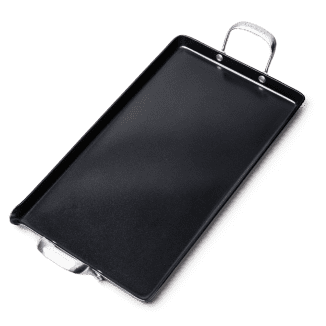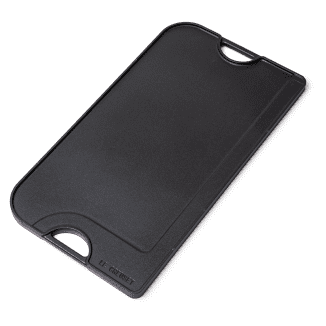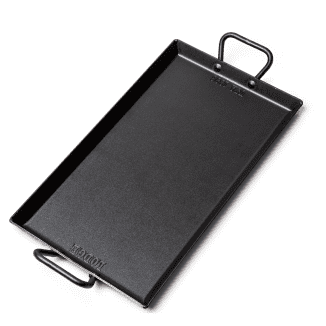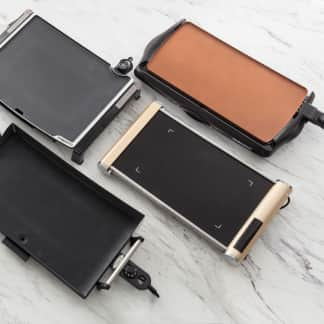The best stovetop griddles cook lots of pancakes, eggs, and burgers perfectly. Our top choice is the Cuisinart Chef’s Classic Nonstick Double Burner Griddle. It’s got a large nonstick cooking surface that makes it a breeze to clean and maintain; big, easy-to-grip handles; and tall walls that keep in grease splatters. We also love the Lodge Pro Grid Iron Reversible Griddle. This cast-iron model is quite heavy and lacks the tall walls and easy-grip handles of our top choice. But it’s an excellent alternative to our favorite nonstick model and does a particularly great job of searing burgers and steaks. It’s also incredibly durable and can be used on the grill or over an open fire.
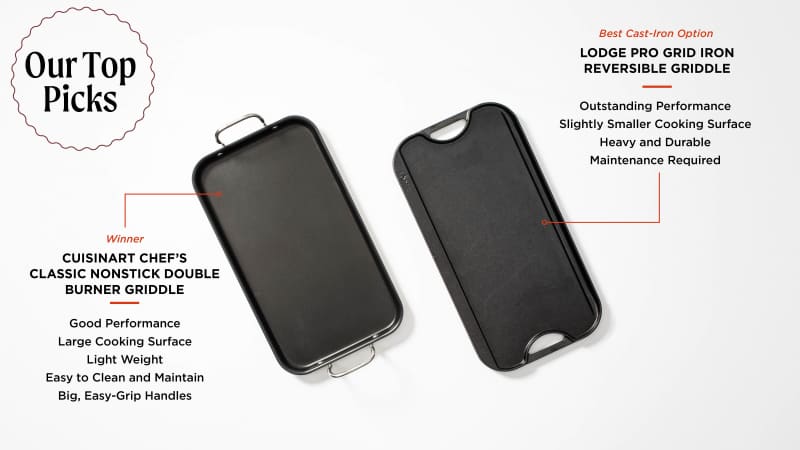
When we’re cooking for a crowd, we love using our favorite electric griddle, the BroilKing Professional Griddle with Backsplash. But it’s quite large, making it a less appealing option for cooks with limited storage or counter space. Stovetop griddles are more compact and easy to store and still give you the extra space you need to make lots of pancakes, eggs, bacon, grilled cheese, and even steaks or burgers on top of your range and in relatively few batches.
For this review, we chose models designed to straddle two burners, as single-burner griddles don’t offer much of a size advantage over our favorite skillets. And we looked at models made from different materials, including nonstick-coated hard-anodized aluminum, stainless steel, carbon steel, and cast iron.
All the griddles performed well, browning pancakes evenly, cooking eggs consistently, and searing the burgers respectably. But a few factors made some models more durable and easier to use, clean, and maintain than others.

Which Material Is Best for Stovetop Griddles?
Stovetop griddles are made from different materials, and the type that’s best for you depends on a number of factors.
Many people prefer models made from nonstick-coated aluminum (either hard anodized or cast). These griddles are lightweight (3 to 6 pounds) and easy to clean, and they heat up quickly. They also require no maintenance, making them especially easy to use. There are a few caveats to buying a nonstick-coated aluminum griddle, though. They’re not as durable as other materials in the long haul. Because their cooking surfaces are relatively thin, they can warp if they are heated unevenly, so make sure that you’re getting about the same amount of heat output from both burners you put them over. You also can’t crank up the heat too high on these griddles—their nonstick coatings should never be heated above 500 degrees F, or they can emit toxic fumes. (This heat maximum means that while you can get a good sear on steaks and burgers with a nonstick-coated griddle, it won’t be quite as dark and crusty as those cooked on carbon-steel or cast-iron models, which can get much hotter safely.) And that nonstick coating can get scratched or flake off over time, allowing food to stick and limiting the griddles’ lifespan. Finally, because they’re made from aluminum, these models won’t work on induction stoves unless their bottom surfaces are made from more induction-friendly material. Our top choice, for example, has an exterior made from stainless steel, so it will work on induction stoves.
Carbon-steel griddles are a touch heavier than aluminum models—8 to 11 pounds—and while all the models we tested came preseasoned with a relatively slick surface, carbon steel does require some maintenance to stay nonstick. (You’ll need to wash and dry carbon-steel models carefully and periodically apply layers of oil to all surfaces to keep them from rusting.) Carbon-steel models are usually a bit thicker than aluminum models and take slightly longer to heat up. But they’re still thinner than cast iron and can warp if heated unevenly. On the plus side, carbon-steel models do a great job of searing steaks and burgers, as they can safely be heated to higher temperatures and also retain heat better than aluminum models. And they can be used on any type of stove, including induction. If you’re careful to heat them evenly, carbon-steel griddles can also be used on grills or over campfires.
Cast-iron griddles are typically the thickest, heaviest (11 to 14 pounds), and most durable; they’re practically impervious to damage and will last a lifetime as long as you maintain them properly. (Like carbon-steel models, they must be washed and dried carefully and oiled periodically to prevent rust from forming.) They can be heated to very high temperatures without any risk of warping and retain heat better than any other type of griddle, so they do an outstanding job of searing meat. They can typically be used on any type of stove, including induction, and can also be used over hot grills or campfires. That heavy, solid construction does come with a trade-off, though: Cast-iron griddles are harder to lift and move, and they take longer than aluminum and carbon-steel models to heat up and cool down.

What to Look For
- Large, Wide Cooking Surfaces: Not surprisingly, since we use these griddles to cook large batches of food, we liked models that gave us as much space as possible to cook on, preferring those that had a usable surface area of at least 160 square inches. More specifically, we preferred griddles with cooking surfaces that were fairly wide. Those with widths smaller than 9.25 inches were a bit more narrow than we prefer, requiring us to stagger and squeeze in just six pancakes at a time, instead of the eight we could make on wider models.
- Walls: We preferred griddles with walls on their sides that were at least 1 inch high. While these walls occasionally got in the way when we flipped pancakes or eggs, they proved their value when we seared burgers, helping to contain any grease that was released. Griddles with no walls often allowed that grease to spatter or flow over their edges—even when the models had dedicated grease troughs—causing dangerous flare-ups as the fat hit the flame.
- Discrete, Moderately Sized Metal Handles: We also liked griddles with handles that extended up and out from the cooking surface, as they were easier to grab and lift than were griddles with flat handles that were simply cut out of the base. We preferred plain metal handles; the handles of one griddle were coated with silicone, which melted a little during a flare-up. We also preferred moderately large handles, which were big enough for hands of all sizes to grip. That said, it was possible for handles to be too big or to extend upward in awkward ways—one model’s large, offset handles stuck out so much that we couldn’t position it properly over two burners without bumping into the stove’s control panel.
- Good Durability: We preferred models that didn’t warp, have parts that melt, or develop other damage during testing. From experience, we know that models with nonstick coatings need to be replaced periodically, as that coating can degrade over time. This isn’t a deal-breaker, but if you want a model that will last forever with good care, choose cast iron.
Other Considerations
- Grease Troughs: In general, we didn’t love these; they didn’t actually collect all that much grease (about a tablespoon or two at most) and subtracted from the available cooking surface, giving us less room to cook on. They were also a pain to clean. While we wouldn’t rule out models that have grease troughs, we’d prefer those with cooking surfaces that were completely flat.
The Tests
- Use to make pancakes
- Use to make eggs over easy
- Use to make Pub Burgers
- Scratch 25 times with a metal spatula
- Wash by hand 5 times
How We Rated
- Performance: We evaluated how evenly the griddles cooked pancakes and eggs and how well they seared burgers.
- Ease of Use: We evaluated how easy it was to lift the griddles, to maneuver different foods and utensils within the griddles while cooking, and to avoid flare-ups. We also rated how quickly the griddles heated up and cooled down and how large the cooking surfaces of the griddles were.
- Durability: We evaluated how well the griddles withstood damage.
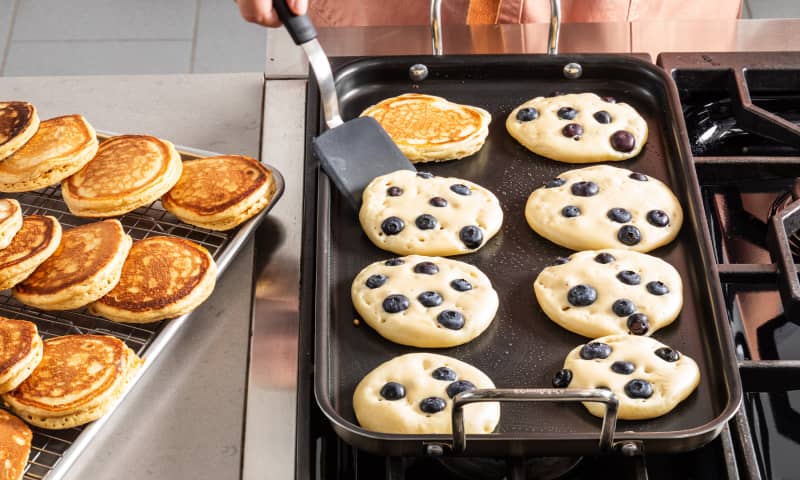

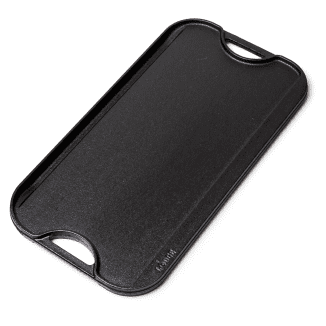




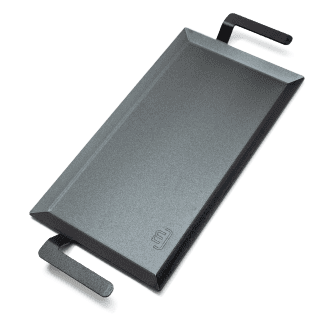
 Buy at Made In Cookware
Buy at Made In Cookware



